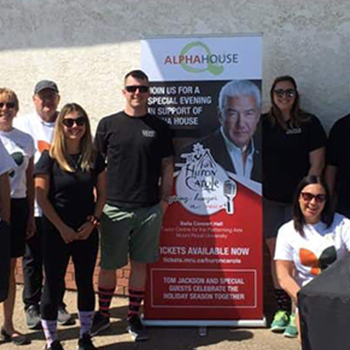Harm Reduction
February 2, 2024 | Alpha House News Opinion Piece
Harm Reduction

The social services sector evolves with the needs of the people that it serves; harm reduction has become a leading framework for those working with individuals facing homelessness and substance use challenges because of its effectiveness in minimizing risk in situations involving physical health, mental health, and/or substance use.
Understanding Harm Reduction
First off, what is harm reduction? Harm reduction is a non-judgmental approach that seeks to reduce the health and social harms associated with an action that is inherently risky. In the social services and addiction sector, we seek to reduce the harm associated with substance use, without requiring individuals that use substances to immediately abstain. We often refer to this as ‘meeting people where they are at’ instead of placing a moral judgement on their behaviour i. The goal is to reduce harm in the immediate while supporting conversations and options around what reducing harm can look like long-term.
Why Not Abstinence?
For many people, substance use is part of recreational activities, and risk of long-term substance use disorders is minimal, but for others it can develop into an addiction that significantly impacts all other areas of that individual’s life iii. A common misconception about harm reduction is that it is an enabling action and that abstinence isn’t an option within a harm reduction model. Harm reduction is about giving individuals the power to make decisions for themselves, and that can mean anything from continuing to use substances, reduced substance use, choosing abstinence, and everything in-between. This framework is here to support individuals in improving their circumstances over time with a non-judgmental approach, and, ultimately, to help people lay the foundation for lasting change in their lives.
Harm Reduction in Practice
Harm reduction in practice can look very different depending on its application and doesn’t only apply to situations involving substance use. People engage in harm reduction practices every day, often without realizing it; for example, putting on sunscreen to reduce the harm of sun exposure, wearing a seatbelt when driving a car to reduce the risk of serious injury in the event of a car accident, and using oven mitts when cooking are all examples of harm reduction measures.
In the realm of substance use, overdose prevention sites are part of reducing harm due to toxicity or quantity. Overdose prevention sites have considerable positive impacts on those in active addiction. These sites reduce the harm of illicit drugs by providing a safe and clean environment where people are monitored by medical professionals to ensure quick, life-saving action in the event of an overdose. These sites are known to reduce costs for the healthcare system, prevent illnesses, and most importantly prevent overdose fatalities ii. Other examples of harm reduction practices and services relating to substance use might be:
- Outreach programs
- Safe supply
- Needle exchange programs
- Opioid replacement therapies
- Drug testing kits/services
- Use of naloxone kits
Harm Reduction and Homelessness
Alongside the need for shelter, unhoused individuals face many challenges that compound experiences of homelessness. We know that individuals living on the street are at a higher risk of mental illness, physical health issues, and basic hygiene challenges; in some cases we see substance use become a coping mechanism for individuals on the street as a response to struggling with the challenges (and trauma) of experiencing homelessness. Unhoused individuals often experience barriers to health care on top of not having access to basic hygiene supplies, resulting in a higher number of negative health outcomes such as infections, Hepatitis B and C, and HIV. This is why ensuring unhoused individuals have access to safe supply like sterile water, needles, and glass pipes is essential to ensuring the safety of unhoused folks.
Harm reduction is a practice related to substance use as one example, but other health interventions are harm reduction practices that are equally important. Access to clean clothing, for example, reduces harm by removing dirt, bacteria, fleas, and other irritants which helps reduce the occurrence of infections, rashes, and disease. Access to showers, as another example, reduces the harm of infestations like scabies, fleas, and head lice which individuals on the street are at a higher risk of due to infrequency of washing supplies iv. Once the immediate safety of the individual is addressed, there is room for support, referrals, and goal setting towards other improved circumstances.
The overall goal of harm reduction is to minimize the negative consequences involved with an inherently risky action (such as substance use) while recognizing that each individual’s circumstances are different and require a unique, non-judgmental approach.
If you want to learn more about the root causes of homelessness, harm reduction, and practical strategies on how you can better navigate interactions with this population, we offer a free 90-minute workshop twice a month at the carya Village Commons. You can learn more about the workshop and available dates here.
References
- Thomas, G. (2005) Harm Reduction Policies and Programs Involved for Persons Involved in the Criminal Justice System. Ottawa: Canadian Centre on Substance Use.
- Mental health. CMHA Ontario. (n.d.). https://ontario.cmha.ca/harm-reduction/#:~:text=What%20are%20some%20examples%20of,for%20people%20who%20inject%20drugs.
- Harm reduction. Harm Reduction | The Homeless Hub. (n.d.). https://www.homelesshub.ca/about-homelessness/substance-use-addiction/harm-reduction
- Thelwell, K. (2020, October 24). Struggles obtaining convenient access to showers. The Borgen Project. https://borgenproject.org/access-to-showers/
